Overview
- Collection Summary
- Home movies shot by Albert Günther Hess including various family and wartime scenes in Germany, Czechoslovakia, and Belgium.
- Credit
- US Holocaust Memorial Museum, gift of Marie Hammerling
Physical Details
- B&W / Color
- Black & White
Administrative Notes
- Legal Status
- Permanent Collection
- Film Source
- Marie Brandes Hammerling
Browse 6 Items In This Collection
Prewar family life in Saxony
Film | Accession Number: 1996.164.1 | RG Number: RG-60.2473 | Film ID: 2276
Family life in Pirna, Germany
Film | Accession Number: 1996.164.1 | RG Number: RG-60.2474 | Film ID: 2276
Playfully fighting over cigarettes
Film | Accession Number: 1996.164.1 | RG Number: RG-60.2475 | Film ID: 2276
Track and field events in Pirna; prewar Jewish life in Germany
Film | Accession Number: 1996.164.1 | RG Number: RG-60.2476 | Film ID: 2276
Wedding in Brussels
Film | Accession Number: 1996.164.1 | RG Number: RG-60.2477 | Film ID: 2276
The Hess Family in Germany and on vacation
Film | Accession Number: 2004.461 | RG Number: RG-60.3927 | Film ID: 2724
- Record last modified:
- 2022-07-28 21:57:40
- This page:
- https://collections.ushmm.org/search/catalog/irn1000023
Download & Licensing
Contact Us
Also in Albert Günther Hess collection
The collection consists of handmade puppets, two photo albums and loose photographs relating to the experiences of Albert Günther Hess and his family before and during the Holocaust in Germany, Belgium, and France and the experiences of Albert in the United States and after his service in World War II. Some of these materials may be combined into a single collection in the future.
Date: before 1939-1957
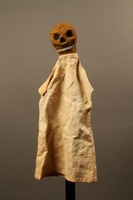
Skull faced hand puppet created by a German Jewish Holocaust survivor and World War II veteran
Object
Handmade, papier-mâché hand puppet with a skull head, created by Albert Guenther Hess in New York as a way to cope with his experiences as a Holocaust survivor and soldier in World War II. Albert Guenther Hess’s family owned a successful chemical factory in the town of Pirna, Germany. Albert studied law, but also had a passion for music and film. In 1933, Albert was fired from his legal position in the Ministry of Justice because he was Jewish. He then took a position as a legal advisor for his family’s business. In 1937, he began working in Belgium as a representative for his family’s company. On May 10, 1940, Germany invaded Belgium and Albert, a German national, was arrested by the Belgian police and detained in Saint Cyprien. He was then sent to Gurs, and Les Milles detention camps in France by the Germans. In February 1941, Albert was released, and traveled to Marseilles. He immigrated to the United States and arrived in New York in March 1941. In 1943, Albert was drafted into the U.S. Army. He served as a translator and investigator for the military intelligence unit of the 44th Infantry Division. His unit assisted in the liberation of Dachau where Albert photographed and documented camp atrocities. Afterwards, he acted as a German translator and interviewer for Nazi prisoners, including Hermann Göring. Albert returned to the United States in 1945 and later served as a secretary for the United Nations.

Blond haired hand puppet created by a German Jewish Holocaust survivor and World War II veteran
Object
Handmade, papier-mâché hand puppet of a blond haired man, created by Albert Guenther Hess in New York as a way to cope with his experiences as a Holocaust survivor and soldier in World War II. Albert Guenther Hess’s family owned a successful chemical factory in the town of Pirna, Germany. Albert studied law, but also had a passion for music and film. In 1933, Albert was fired from his legal position in the Ministry of Justice because he was Jewish. He then took a position as a legal advisor for his family’s business. In 1937, he began working in Belgium as a representative for his family’s company. On May 10, 1940, Germany invaded Belgium and Albert, a German national, was arrested by the Belgian police and detained in Saint Cyprien. He was then sent to Gurs, and Les Milles detention camps in France by the Germans. In February 1941, Albert was released, and traveled to Marseilles. He immigrated to the United States and arrived in New York in March 1941. In 1943, Albert was drafted into the U.S. Army. He served as a translator and investigator for the military intelligence unit of the 44th Infantry Division. His unit assisted in the liberation of Dachau where Albert photographed and documented camp atrocities. Afterwards, he acted as a German translator and interviewer for Nazi prisoners, including Hermann Göring. Albert returned to the United States in 1945 and later served as a secretary for the United Nations.
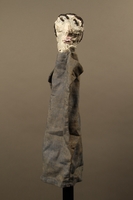
Pale faced hand puppet created by a German Jewish Holocaust survivor and World War II veteran
Object
Handmade, papier-mâché hand puppet of a pale faced man, created by Albert Guenther Hess in New York as a way to cope with his experiences as a Holocaust survivor and soldier in World War II. Albert Guenther Hess’s family owned a successful chemical factory in the town of Pirna, Germany. Albert studied law, but also had a passion for music and film. In 1933, Albert was fired from his legal position in the Ministry of Justice because he was Jewish. He then took a position as a legal advisor for his family’s business. In 1937, he began working in Belgium as a representative for his family’s company. On May 10, 1940, Germany invaded Belgium and Albert, a German national, was arrested by the Belgian police and detained in Saint Cyprien. He was then sent to Gurs, and Les Milles detention camps in France by the Germans. In February 1941, Albert was released, and traveled to Marseilles. He immigrated to the United States and arrived in New York in March 1941. In 1943, Albert was drafted into the U.S. Army. He served as a translator and investigator for the military intelligence unit of the 44th Infantry Division. His unit assisted in the liberation of Dachau where Albert photographed and documented camp atrocities. Afterwards, he acted as a German translator and interviewer for Nazi prisoners, including Hermann Göring. Albert returned to the United States in 1945 and later served as a secretary for the United Nations.
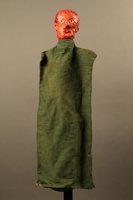
Red haired hand puppet created by a German Jewish Holocaust survivor and World War II veteran
Object
Handmade, papier-mâché hand puppet of a red faced man created by Albert Guenther Hess in New York as a way to cope with his experiences as a Holocaust survivor and soldier in World War II. Albert Guenther Hess’s family owned a successful chemical factory in the town of Pirna, Germany. Albert studied law, but also had a passion for music and film. In 1933, Albert was fired from his legal position in the Ministry of Justice because he was Jewish. He then took a position as a legal advisor for his family’s business. In 1937, he began working in Belgium as a representative for his family’s company. On May 10, 1940, Germany invaded Belgium and Albert, a German national, was arrested by the Belgian police and detained in Saint Cyprien. He was then sent to Gurs, and Les Milles detention camps in France by the Germans. In February 1941, Albert was released, and traveled to Marseilles. He immigrated to the United States and arrived in New York in March 1941. In 1943, Albert was drafted into the U.S. Army. He served as a translator and investigator for the military intelligence unit of the 44th Infantry Division. His unit assisted in the liberation of Dachau where Albert photographed and documented camp atrocities. Afterwards, he acted as a German translator and interviewer for Nazi prisoners, including Hermann Göring. Albert returned to the United States in 1945 and later served as a secretary for the United Nations.

Bird head hand puppet created by a German Jewish Holocaust survivor and World War II veteran
Object
Handmade, papier-mâché hand puppet of a bird created by Albert Guenther Hess in New York as a way to cope with his experiences as a Holocaust survivor and soldier in World War II. Albert Guenther Hess’s family owned a successful chemical factory in the town of Pirna, Germany. Albert studied law, but also had a passion for music and film. In 1933, Albert was fired from his legal position in the Ministry of Justice because he was Jewish. He then took a position as a legal advisor for his family’s business. In 1937, he began working in Belgium as a representative for his family’s company. On May 10, 1940, Germany invaded Belgium and Albert, a German national, was arrested by the Belgian police and detained in Saint Cyprien. He was then sent to Gurs, and Les Milles detention camps in France by the Germans. In February 1941, Albert was released, and traveled to Marseilles. He immigrated to the United States and arrived in New York in March 1941. In 1943, Albert was drafted into the U.S. Army. He served as a translator and investigator for the military intelligence unit of the 44th Infantry Division. His unit assisted in the liberation of Dachau where Albert photographed and documented camp atrocities. Afterwards, he acted as a German translator and interviewer for Nazi prisoners, including Hermann Göring. Albert returned to the United States in 1945 and later served as a secretary for the United Nations.
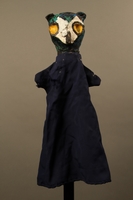
Owl head hand puppet made by a German Jewish Holocaust survivor and World War II veteran
Object
Handmade, papier-mâché hand puppet of an owl created by Albert Guenther Hess in New York as a way to cope with his experiences as a Holocaust survivor and soldier in World War II. Albert Guenther Hess’s family owned a successful chemical factory in the town of Pirna, Germany. Albert studied law, but also had a passion for music and film. In 1933, Albert was fired from his legal position in the Ministry of Justice because he was Jewish. He then took a position as a legal advisor for his family’s business. In 1937, he began working in Belgium as a representative for his family’s company. On May 10, 1940, Germany invaded Belgium and Albert, a German national, was arrested by the Belgian police and detained in Saint Cyprien. He was then sent to Gurs, and Les Milles detention camps in France by the Germans. In February 1941, Albert was released, and traveled to Marseilles. He immigrated to the United States and arrived in New York in March 1941. In 1943, Albert was drafted into the U.S. Army. He served as a translator and investigator for the military intelligence unit of the 44th Infantry Division. His unit assisted in the liberation of Dachau where Albert photographed and documented camp atrocities. Afterwards, he acted as a German translator and interviewer for Nazi prisoners, including Hermann Göring. Albert returned to the United States in 1945 and later served as a secretary for the United Nations.

Hand puppet of a woman created by a German Jewish Holocaust survivor and World War II veteran
Object
Handmade, papier-mâché hand puppet of a dark haired woman created by Albert Guenther Hess in New York as a way to cope with his experiences as a Holocaust survivor and soldier in World War II. Albert Guenther Hess’s family owned a successful chemical factory in the town of Pirna, Germany. Albert studied law, but also had a passion for music and film. In 1933, Albert was fired from his legal position in the Ministry of Justice because he was Jewish. He then took a position as a legal advisor for his family’s business. In 1937, he began working in Belgium as a representative for his family’s company. On May 10, 1940, Germany invaded Belgium and Albert, a German national, was arrested by the Belgian police and detained in Saint Cyprien. He was then sent to Gurs, and Les Milles detention camps in France by the Germans. In February 1941, Albert was released, and traveled to Marseilles. He immigrated to the United States and arrived in New York in March 1941. In 1943, Albert was drafted into the U.S. Army. He served as a translator and investigator for the military intelligence unit of the 44th Infantry Division. His unit assisted in the liberation of Dachau where Albert photographed and documented camp atrocities. Afterwards, he acted as a German translator and interviewer for Nazi prisoners, including Hermann Göring. Albert returned to the United States in 1945 and later served as a secretary for the United Nations.
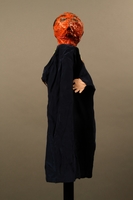
Orange and blue hand puppet created by a German Jewish Holocaust survivor and World War II Veteran
Object
Handmade, papier-mâché hand puppet with hands created by Albert Guenther Hess in New York as a way to cope with his experiences as a Holocaust survivor and soldier in World War II. Albert Guenther Hess’s family owned a successful chemical factory in the town of Pirna, Germany. Albert studied law, but also had a passion for music and film. In 1933, Albert was fired from his legal position in the Ministry of Justice because he was Jewish. He then took a position as a legal advisor for his family’s business. In 1937, he began working in Belgium as a representative for his family’s company. On May 10, 1940, Germany invaded Belgium and Albert, a German national, was arrested by the Belgian police and detained in Saint Cyprien. He was then sent to Gurs, and Les Milles detention camps in France by the Germans. In February 1941, Albert was released, and traveled to Marseilles. He immigrated to the United States and arrived in New York in March 1941. In 1943, Albert was drafted into the U.S. Army. He served as a translator and investigator for the military intelligence unit of the 44th Infantry Division. His unit assisted in the liberation of Dachau where Albert photographed and documented camp atrocities. Afterwards, he acted as a German translator and interviewer for Nazi prisoners, including Hermann Göring. Albert returned to the United States in 1945 and later served as a secretary for the United Nations.
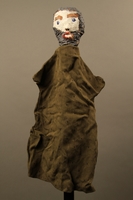
Bearded man hand puppet created by a German Jewish Holocaust survivor and World War II veteran
Object
Handmade, papier-mâché hand puppet of a bearded man created by Albert Guenther Hess in New York as a way to cope with his experiences as a Holocaust survivor and soldier in World War II. Albert Guenther Hess’s family owned a successful chemical factory in the town of Pirna, Germany. Albert studied law, but also had a passion for music and film. In 1933, Albert was fired from his legal position in the Ministry of Justice because he was Jewish. He then took a position as a legal advisor for his family’s business. In 1937, he began working in Belgium as a representative for his family’s company. On May 10, 1940, Germany invaded Belgium and Albert, a German national, was arrested by the Belgian police and detained in Saint Cyprien. He was then sent to Gurs, and Les Milles detention camps in France by the Germans. In February 1941, Albert was released, and traveled to Marseilles. He immigrated to the United States and arrived in New York in March 1941. In 1943, Albert was drafted into the U.S. Army. He served as a translator and investigator for the military intelligence unit of the 44th Infantry Division. His unit assisted in the liberation of Dachau where Albert photographed and documented camp atrocities. Afterwards, he acted as a German translator and interviewer for Nazi prisoners, including Hermann Göring. Albert returned to the United States in 1945 and later served as a secretary for the United Nations.
Marie Hess Brandes collection
Document
Consists of photographs taken by Albert Günther Hess during World War II, including photographs taken upon the liberation of the Dachau concentration camp and of Hermann Göring after his arrest. Also includes identity and immigration papers of Gisela Oppens Hess, issued in 1943 by the Ministry of Interior of Portugal. Accretion found in Photo Archives binders: Photograph of Dachau at liberation, photograph of Hermann Goering following his surrender to troops of the U.S. Seventh Army near Mauterndorf.
Albert Günther Hess photographs
Document
Contains two photo albums and loose photographs depicting the family of Albert Günther Hess before and after the war as well as images of Nazi demonstrations in Germany.



